American persimmon
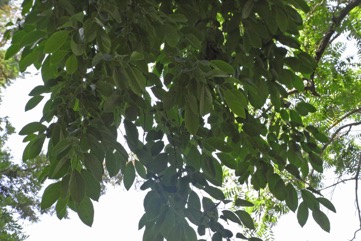
It is a temperate plant. It is native to the Eastern United States. It grows naturally in river valley forests. It is cold hardy when dormant and mature. Trees need 300 chill hours. It suits hardiness zones 5-9.
Also known as:
American seedless persimmon, Halle beth, Piakmine, Pohon eben amerika, Possumwood, Ougoufle, Simmon, Viržinski ebenovec
Synonyms
- Diospyros angustifolia Audib. ex Spach
- Diospyros calycina Audib. ex Spach
- Diospyros caroliniana Muhl. ex Raf.
- Diospyros ciliata Raf.
- Diospyros concolor Moench
- Diospyros digyna Loudon
- Diospyros distyla K. Koch
- Diospyros fertilis Loudon
- Diospyros guaiacana C. C. Robin
- Diospyros intermedia Loudon
- Diospyros lucida Loudon
- Diospyros mosieri Small
- Diospyros persimon Wikstr.
- Diospyros pubescens Pursh [Illegitimate]
- Diospyros stricta Loudon [Illegitimate]
- Diospyros undulata Hiern
- Diospyros virginiana var. mosieri (Small) Sarg.
- Disopyros virginiana var. virginiana
- Persimon virginiana (L.) Raf.
Edible Portion
- Fruit, Leaves - tea, Seeds - coffee
Where does American persimmon grow?
Found in: Asia, Australia, Britain, Himalayas, Indochina, Indonesia, Macedonia, Nepal, North America, Russia, SE Asia, Sikkim, Slovenia, Thailand, United States
Notes: There are about 485 species of Diospyros mostly in the tropics.
Growing American persimmon
Cultivation: Plants can be grown by seed. It can be grown by cuttings or from suckers and by grafting.
Edible Uses: The fruit are eaten raw once ripe. They are also used in cakes, breads, pies, puddings and for jam and pancakes. They can also be dried for later use. They have been used for bread. They have been fermented into beer or wine or vinegar. The leaves can be used for a tea. Roasted seeds have been used as a coffee substitute.
Production: A mature tree can produce 45 kg of fruit in one year.
Nutrition Info
per 100g edible portion| Edible Part | Energy (kcal) | Protein (g) | Iron (mg) | Vitamin A (ug) | Vitamin c (mg) | Zinc (mg) | % Water |
|---|---|---|---|---|---|---|---|
| Fruit - raw | 127 | 0.8 | 2.5 | - | 66 | - | 64.4 |
American persimmon Photos

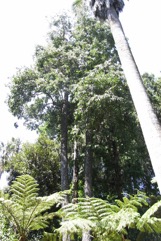
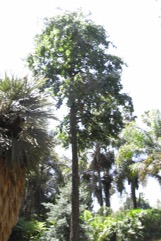
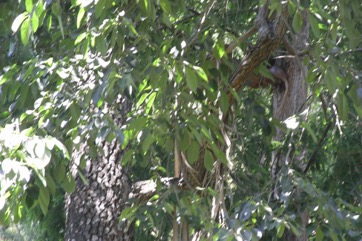
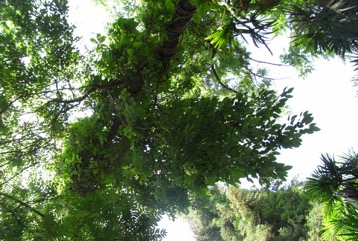
References
Anderson, E. F., 1993, Plants and people of the Golden Triangle. Dioscorides Press. p 209
Beckstrom-Sternberg, Stephen M., and James A. Duke. "The Foodplant Database." http://probe.nalusda.gov:8300/cgi-bin/browse/foodplantdb.(ACEDB version 4.0 - data version July 1994)
Bodkin, F., 1991, Encyclopedia Botanica. Cornstalk publishing, p 346
Brouk, B., 1975, Plants Consumed by Man. Academic Press, London. p 194
Cheifetz, A., (ed), 1999, 500 popular vegetables, herbs, fruits and nuts for Australian Gardeners. Random House p 190
Coombes, A.J., 2000, Trees. Dorling Kindersley Handbooks. p 139
Cundall, P., (ed.), 2004, Gardening Australia: flora: the gardener's bible. ABC Books. p 504
Duke, J.A., 1992, Handbook of Edible Weeds. CRC Press. p 88
Elias, T.S. & Dykeman P.A., 1990, Edible Wild Plants. A North American Field guide. Sterling, New York p 238
Esperanca, M. J., 1988. Surviving in the wild. A glance at the wild plants and their uses. Vol. 2. p 147
Etherington, K., & Imwold, D., (Eds), 2001, Botanica's Trees & Shrubs. The illustrated A-Z of over 8500 trees and shrubs. Random House, Australia. p 264
Facciola, S., 1998, Cornucopia 2: a Source Book of Edible Plants. Kampong Publications, p 92
Gouldstone, S., 1983, Growing your own Food-bearing Plants in Australia. Macmillan p 122
Grandtner, M. M., 2008, World Dictionary of Trees. Wood and Forest Science Department. Laval University, Quebec, Qc Canada. (Internet database http://www.WDT.QC.ca)
Hedrick, U.P., 1919, (Ed.), Sturtevant's edible plants of the world. p 278
Hermandez Bermejo, J.E., and Leon, J. (Eds.), 1994, Neglected Crops. 1492 from a different perspective. FAO Plant Production and Protection Series No 26. FAO, Rome. p 30
Hibbert, M., 2002, The Aussie Plant Finder 2002, Florilegium. p 87
Jackes, D. A., Edible Forest Gardens
John, L., & Stevenson, V., 1979, The Complete Book of Fruit. Angus & Robertson p 227
Kiple, K.F. & Ornelas, K.C., (eds), 2000, The Cambridge World History of Food. CUP p 1833
Little, E.L., 1980, National Audubon Society Field Guide to North American Trees. Alfred A. Knopf. p 635
Lord, E.E., & Willis, J.H., 1999, Shrubs and Trees for Australian gardens. Lothian. p 53
Lyle, S., 2006, Discovering fruit and nuts. Land Links. p 185
Martin, F.W. & Ruberte, R.M., 1979, Edible Leaves of the Tropics. Antillian College Press, Mayaguez, Puerto Rico. p 190 (As Diospyros virginiana var. mosieri)
NYBG Herbarium "edible"
Plants for a Future database, The Field, Penpol, Lostwithiel, Cornwall, PL22 0NG, UK. http://www.scs.leeds.ac.uk/pfaf/
Recher, P, 2001, Fruit Spirit Botanical Gardens Plant Index. www.nrg.com.au/~recher/ seedlist.html p 2
Self, M., 199, Phoenix Seeds catalogue. p 16
Sp. pl. 2:1057. 1753
Sukarya, D. G., (Ed.) 2013, 3,500 Plant Species of the Botanic Gardens of Indonesia. LIPI p 240
Suresh, C. P. et al, 2014, Wild Edible Tree Fruits of Sikkim Himalayas. Journal of Tree Sciences 33(1): 43-48
USDA, ARS, National Genetic Resources Program. Germplasm Resources Information Network - (GRIN). [Online Database] National Germplasm Resources Laboratory, Beltsville, Maryland. Available: www.ars-grin.gov/cgi-bin/npgs/html/econ.pl (10 April 2000)
van Wyk, B., 2005, Food Plants of the World. An illustrated guide. Timber press. p 179
Wild Edible Plants of the Whitmire Wildflower Garden. Missouri Botanical Gardens.
World Checklist of Useful Plant Species 2020. Royal Botanic Gardens, Kew
www.worldagroforestrycentre.org/treedb/